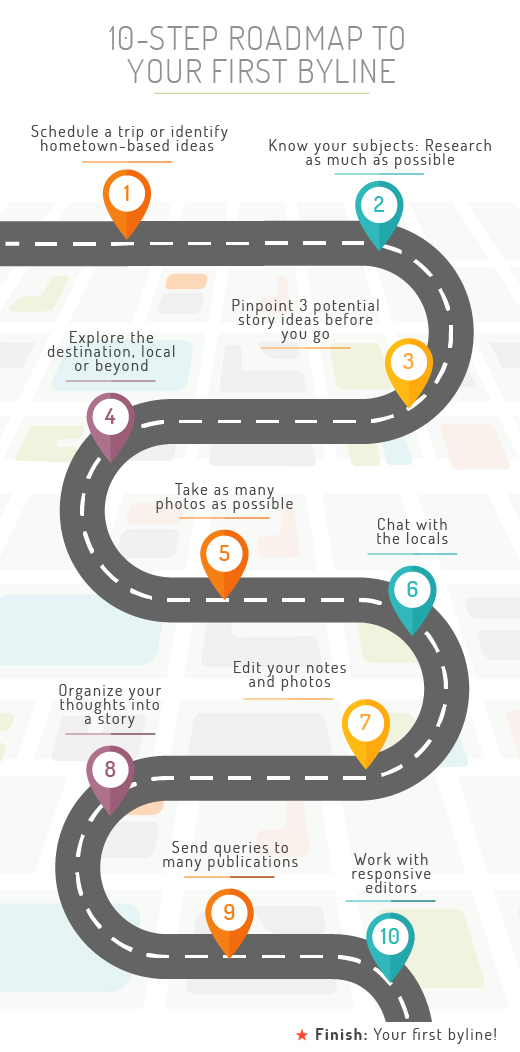As a longtime cross-country mountain biker, I’m frequently asked what the steps are to making it 100 miles at a time over mountain passes and through rugged – and often unforgiving – terrain.
Obviously, no one just gets up one morning and sets out to bike 100 miles into the mountains. You have
The same is true of scoring your first published travel story. You don’t just wake up one day and announce, “I’m going to write a story and get it published,” and expect that it will happen by the end of the day, right? Of course not: There is a series of steps you need to take to make it happen.
Of course, you can take these steps in about a week… then repeat over and over to start seeing repeat success.
Here’s a handy-dandy roadmap to your first byline that outlines each step from start to finish, so you don’t have to guess at what to do next.
1. Schedule a trip or identify hometown-based ideas.
You don’t have to spend money on a big, elaborate trip halfway around the world to get a byline. In fact, you can write about any trip you’ve taken within the past two years – although if it’s been a while, you’ll need to go the extra mile and double-check your facts (restaurants close or change hands, trains get rerouted). Even better: You don’t have to take a trip at all. Writing about the appealing aspects of visiting your own hometown is usually a faster way to snag that first published piece.
2. Know your subjects: Research as much as possible.
Once you’ve identified the locale, be it international or in your own backyard, it’s time to get to know it a bit better. Search the Internet, guidebooks, history books or any other relevant resource for insight and ideas. The more you know about where you’re going, the easier it will be to home in on potential story ideas. This would also be the time to take classes – such as a photography workshop or a writing seminar – that can put you in the best possible position to be proficient as a freelance travel writer.
3. Pinpoint three potential story ideas before you go.
Once you’ve done some investigating into your destination or hometown hotspots, narrow your focus so you don’t feel overwhelmed. Choose three areas of interest that you feel passionate about sharing with readers – it can be anything from an activity (such as snorkeling or dining on local specialties) to a point-by-point walking tour of a neighborhood to a new hotel or museum. If you have some ideas before you go, your work on the ground will be more purposeful. That’s not to say that you can’t write about anything you encounter along the way – you absolutely should be open to more story ideas while you’re there. The more, the better!
4. Explore the destination, local or beyond.
This is the fun part! Get out there and experience all that you can.
5. Take as many photos as possible.
Even if you’re not ready to lug around a tripod for that giant, wide-angle landscape shot, that doesn’t mean you can’t take a lot of “detail” photos that will illustrate things like meals, shopping options or other aspects of the experience. And even if a publication doesn’t use those, they will be extremely helpful in giving you visual information that you can use when writing descriptions in the story.
6. Chat with the locals.
Your story will have more depth and better observations if you spend some time getting to know natives and expats along the way. In addition, quotes from locals go a long way toward expanding your story’s vision and they will give your story more credibility and an authoritative tone.
7. Edit your notes and photos.
You can do this while still on the trip – which is recommended, as it will help you continue to pare down your notes so that you can focus on what you really want to cover in your story – or you can wait until you come home. Either way, it’s a crucial step toward honing the tale you will tell and identifying the shots that perfectly illustrate it.
8. Organize your thoughts into a story.
Here’s where that writing workshop or online course will come in handy, because you’ll have the templates for easily setting up the kind of story that editors are looking for. Keep in mind the most important components of a good travel story: A strong first sentence or two to hook the reader; a paragraph explaining why the story is important; and solid transitions between paragraphs. And, of course, fact-check and spellcheck like crazy – and don’t stop working on the drafts until the final feels right.
9. Send queries to many publications.
There’s no such thing as sending a story out too many times – you want to identify as many publications as possible that might be interested in publishing your story. It’s a game of numbers, really: The more you send, the better your chances are that you will connect with the right editor at the right time. This is also the time to check the archives of the publications to make sure that your story hasn’t been covered within the last year or two.
10. Work with responsive editors.
So now your story is out there, and you may be getting some feedback – maybe that this particular destination is one that a publication doesn’t need right now, or an editor likes your story but it needs some rewrites. It’s also possible that you haven’t heard anything at all yet, but don’t get discouraged: Sometimes the querying step takes a few tries before you hit the finish line.
If you’re persistent, though, and follow through at each phase, you’ll be seeing your name in print in no time at all.
Travel Photography Resources
5 Dos and 2 Don’ts for Travel Photography
Take Great Photos And Get Paid More For Your Travel Articles
Turning a Photography Hobby into a Monthly Income
The Pros Of Selling Your Images As Stock Photography
16 Mobile Photography Tips And Tricks Every Photographer Should Know
Camera Buying Guide: How to Buy the Right Camera
Travel Writing Resources
How To Become A Travel Writer – The Easy Way
Easy Steps To Landing Your First Byline As A Travel Writer
Marketing For Travel Writers: 5 Ways To Get Started
22 Travel Story Ideas To Get You Published


